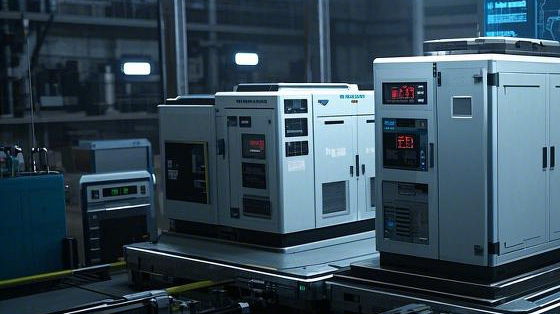Unraveling the Hidden Impact of Quantum Computing on Compact Circuitry Designs
I. The Current State of the Global Supply Chain
A. Geopolitical Tensions
Geopolitical rivalries between major economies, such as the United States and China, have led to the implementation of trade tariffs and restrictions. These measures have directly affected the flow of raw materials and components essential for compact energy solutions. For example, rare earth elements, which are crucial for the production of high - performance batteries and magnets in compact energy systems, are predominantly mined and processed in China. The trade disputes have led to concerns about potential supply disruptions, causing companies to seek alternative sources. However, finding viable substitutes for rare earth elements in compact energy applications has proven to be a challenging task due to their unique properties. The resulting uncertainty in the supply of these critical materials has increased costs for manufacturers of compact energy solutions. Producers have had to invest in research to develop alternative materials or more efficient extraction and recycling methods. This not only diverts resources from other areas of innovation but also adds to the overall cost of production, which may be passed on to consumers in the form of higher prices for products that rely on compact energy solutions.

Natural disasters, such as earthquakes, floods, and hurricanes, have had a significant impact on the global supply chain. In regions that are major hubs for the production of components used in compact energy solutions, these disasters can disrupt manufacturing facilities and transportation networks. For instance, a major earthquake in Japan, a key producer of advanced semiconductor components used in energy - management systems for compact energy solutions, can halt production for extended periods. This disruption ripples through the global supply chain, as other manufacturers around the world that rely on these components are left waiting for supplies. The lack of available components can delay the production of finished products, leading to lost sales opportunities and increased inventory costs for companies in the compact energy solutions industry. Moreover, the recovery process from natural disasters is often costly and time - consuming. Manufacturers may need to invest in rebuilding and retrofitting their facilities to make them more resilient to future disasters. This additional investment further strains the resources of companies in the supply chain and can impact the overall competitiveness of compact energy solutions in the global market.
C. Trade Policies
Trade policies, including free - trade agreements and customs regulations, play a crucial role in shaping the global supply chain. The negotiation and implementation of new free - trade agreements can either facilitate or impede the flow of goods related to compact energy solutions. For example, a new free - trade agreement between two major economies may reduce tariffs on certain raw materials and components used in compact energy production. This can lower the cost of production for manufacturers, making their products more competitive in the global market. On the other hand, changes in customs regulations, such as stricter inspection requirements or longer clearance times, can slow down the movement of goods. In the compact energy solutions industry, where time - to - market is often critical, these delays can be costly. Components may arrive late at manufacturing plants, causing production bottlenecks and delaying the launch of new products. Additionally, compliance with different trade policies across various countries can be complex and resource - intensive for companies involved in the production and distribution of compact energy solutions. They need to invest in legal and regulatory expertise to ensure that they are operating within the bounds of the law, which adds to their operational costs.
D. Technological Evolution
The rapid evolution of technology is also driving significant changes in the global supply chain. The rise of Industry 4.0, with its emphasis on automation, artificial intelligence, and the Internet of Things (IoT), is transforming the way products are designed, manufactured, and distributed. In the context of compact energy solutions, technological advancements are enabling the development of more efficient and powerful energy - storage and conversion devices. However, these technological changes also require a highly skilled workforce and significant investment in research and development. As new technologies emerge, the demand for certain components and materials may change rapidly. For example, the development of solid - state batteries, which promise higher energy density and faster charging times compared to traditional lithium - ion batteries, may reduce the demand for some of the components currently used in lithium - ion battery production. This shift in demand can disrupt the existing supply chain, as manufacturers of these components may need to retool their production lines or find new markets for their products. Moreover, the integration of IoT technology in compact energy solutions allows for better monitoring and management of energy usage. This has led to the development of smart energy - management systems, which require a complex network of sensors, communication devices, and software. The production and supply of these components pose new challenges in terms of ensuring compatibility, security, and seamless integration.
II. Impact on Compact Energy Solutions
A. Component Sourcing
The shifts in the global supply chain have made component sourcing a major challenge for manufacturers of compact energy solutions. With the uncertainty caused by geopolitical tensions and trade policies, companies are finding it difficult to rely on traditional sources of components. As mentioned earlier, the availability of rare earth elements has been affected, and this has forced companies to look for alternative sources or develop substitute materials. In addition to rare earths, other components such as semiconductors, which are essential for the control and management of energy in compact energy systems, have also faced supply - chain disruptions. The shortage of semiconductors, which has been exacerbated by the COVID - 19 pandemic, has led to production delays for many compact energy solution manufacturers. To mitigate these risks, companies are now diversifying their component - sourcing strategies. They are exploring partnerships with suppliers in different regions, investing in local production capabilities, and even developing their own in - house component manufacturing facilities. However, these strategies require significant investment and time to implement, and there are no guarantees that they will completely eliminate the risks associated with supply - chain disruptions.
B. Production Costs
The global supply chain shifts have had a direct impact on the production costs of compact energy solutions. The increased cost of raw materials due to supply - chain disruptions, as well as the need to invest in alternative sourcing strategies and compliance with changing trade policies, has led to higher production costs. For example, the search for alternative sources of rare earth elements may involve higher extraction costs or longer transportation distances, both of which add to the overall cost of the raw materials. In addition, the need to retool production lines to adapt to new component requirements or technological changes can be extremely expensive. These increased production costs can have a significant impact on the competitiveness of compact energy solutions in the market. If manufacturers are unable to absorb these costs, they may be forced to increase the prices of their products, which could reduce demand. On the other hand, if they try to maintain prices, their profit margins may be squeezed, limiting their ability to invest in further research and development or expansion.
C. Product Innovation
Despite the challenges, the global supply chain shifts also present opportunities for product innovation in the compact energy solutions industry. The need to find alternative materials and components due to supply - chain disruptions has spurred research and development efforts. For example, the search for substitutes for rare earth elements has led to the exploration of new materials and alloys that may offer similar or even better performance in compact energy applications. In addition, the integration of new technologies such as IoT and artificial intelligence in compact energy solutions has opened up new possibilities for product innovation. Smart energy - management systems, which can optimize energy usage based on real - time data, are becoming increasingly popular. These systems not only improve the efficiency of compact energy solutions but also enhance the user experience. Moreover, the changing global supply chain has forced companies to be more agile and innovative in their product development processes. They are now more likely to collaborate with other stakeholders, such as research institutions and technology startups, to develop new and improved compact energy solutions. This cross - sector collaboration can lead to the emergence of novel technologies and business models that may not have been possible under a more stable supply - chain environment.
D. Market Access
The global supply chain shifts have also affected the market access for compact energy solutions. Changes in trade policies and geopolitical tensions can create barriers to entry in certain markets. For example, the imposition of trade tariffs or restrictions on products containing certain components may make it more difficult for manufacturers to sell their compact energy solutions in those markets. On the other hand, the development of new free - trade agreements or the opening up of new markets can provide opportunities for expansion. In addition, the increasing demand for sustainable and energy - efficient solutions in many parts of the world is creating new market opportunities for compact energy solutions. However, to take advantage of these opportunities, companies need to be able to navigate the complex global supply chain and ensure the availability of their products in these markets. This requires effective supply - chain management and the ability to adapt to changing market conditions.
III. Strategies for Mitigating the Impact
A. Supply - Chain Diversification
As mentioned earlier, supply - chain diversification is one of the key strategies for mitigating the impact of global supply chain shifts on compact energy solutions. This involves reducing reliance on a single source of components or raw materials and instead sourcing from multiple regions or suppliers. By diversifying their supply chains, companies can reduce the risk of disruptions caused by geopolitical tensions, natural disasters, or other factors. For example, a manufacturer of compact energy solutions may source rare earth elements from multiple countries, including Australia, the United States, and some African nations, in addition to China. This way, if there is a supply disruption in one region, the company can still obtain the necessary materials from other sources. In addition to sourcing from different regions, companies can also consider alternative suppliers within the same region. This can help to increase competition and reduce the risk of being overly dependent on a single supplier. However, supply - chain diversification requires careful planning and management. Companies need to evaluate the reliability, quality, and cost - effectiveness of potential suppliers and establish strong relationships with them.
B. Investment in Research and Development
Investing in research and development is another important strategy for mitigating the impact of global supply chain shifts. As the availability of certain components and materials becomes uncertain, companies need to develop alternative solutions. This may involve researching and developing new materials, improving manufacturing processes, or finding ways to recycle and reuse existing materials. For example, research into alternative materials for batteries that do not rely on rare earth elements is an area of active investigation. By investing in R&D, companies can not only reduce their dependence on scarce resources but also develop more efficient and sustainable compact energy solutions. In addition, R&D efforts can focus on improving the integration of new technologies such as IoT and artificial intelligence in compact energy systems. This can lead to the development of more advanced and competitive products. However, investment in R&D requires significant financial resources and a long - term commitment. Companies need to balance the potential benefits of R&D with the short - term costs and risks.
C. Strengthening Supplier Relationships
Strengthening relationships with suppliers is crucial for ensuring the stability of the supply chain. By working closely with suppliers, companies can better understand their capabilities, production schedules, and potential risks. This can help to identify and address issues before they lead to major disruptions. For example, a manufacturer of compact energy solutions can collaborate with its suppliers to develop contingency plans in case of natural disasters or other emergencies. In addition, by providing suppliers with long - term contracts and incentives, companies can encourage them to invest in capacity expansion and quality improvement. This can help to ensure a reliable supply of components and raw materials. Moreover, maintaining open lines of communication with suppliers can also help to address any issues related to changing trade policies or regulatory requirements. However, building and maintaining strong supplier relationships requires effort and resources. Companies need to invest in relationship - building activities and establish clear communication channels with their suppliers.
D. Adopting Agile Manufacturing Practices
Adopting agile manufacturing practices can help companies in the compact energy solutions industry to better respond to the changing global supply chain. Agile manufacturing involves the ability to quickly adapt to changes in demand, supply, or technology. This can be achieved through the use of flexible production systems, modular product designs, and real - time monitoring and control. For example, a company that uses modular product designs can easily switch between different components or suppliers without having to retool its entire production line. In addition, real - time monitoring and control systems can provide companies with up - to - date information on the status of their supply chain, allowing them to make informed decisions in a timely manner. Agile manufacturing also requires a highly skilled and flexible workforce. Companies need to invest in training and development to ensure that their employees have the necessary skills to operate in an agile manufacturing environment. However, implementing agile manufacturing practices may require significant investment in new technologies and processes, as well as a cultural change within the organization.
IV. Conclusion
The global supply chain shifts are having a profound impact on compact energy solutions. The challenges posed by geopolitical tensions, natural disasters, trade policies, and technological evolution are forcing companies in this industry to adapt and innovate. While these shifts create significant challenges in terms of component sourcing, production costs, market access, and product innovation, they also present opportunities for those companies that are able to navigate the complex global supply chain and take advantage of emerging trends. By implementing strategies such as supply - chain diversification, investment in research and development, strengthening supplier relationships, and adopting agile manufacturing practices, companies can mitigate the negative impact of global supply chain shifts and position themselves for success in the evolving market for compact energy solutions. As the demand for sustainable and energy - efficient solutions continues to grow, the compact energy solutions industry will play a crucial role in shaping the future of energy. However, to fully realize its potential, the industry needs to address the challenges posed by the global supply chain shifts and continue to innovate and adapt.





